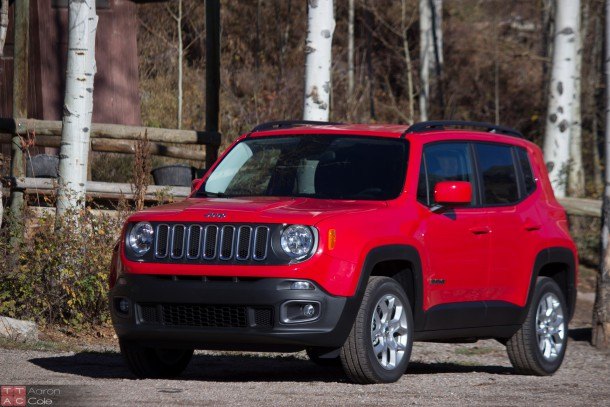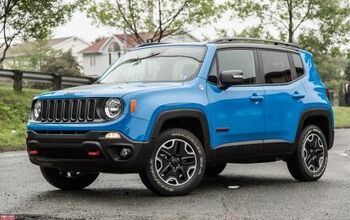2015 Jeep Renegade Latitude Review - The Sibling Complex

2015 Jeep Renegade Latitude 4x4
There are myriad ways to improve SUVs and Jeep won’t do any of them to the Wrangler.
Instead, the Wrangler remains hopelessly impractical, wonderfully unapologetic and, to own, like living with a Libertarian: there are no compromises and everything is wonderful when you play by their rules.
Thankfully for the rest of us, who welcome a little compromise, there are other Jeeps. A crowd of SUVs — and soon to be pickup — will sport the seven-slot grille for mountains of money to keep FCA running well into the black at the moment. When it’s convenient, those cars are compared to the Wrangler to tout their capabilities. When it’s not, well, let’s remember the Compass.
Like Robert Hunter said (kind of): The problem with the 2015 Jeep Renegade is the problem with me.
Exterior
From the outside, the Jeep Renegade oozes kitsch. Littered with a half dozen Easter Eggs that I couldn’t care less about, there are a few functional features such as the MySky removable roof panels (which require a remarkably heavy key or equivalent Torx screwdriver to remove) and large greenhouse that I appreciate.
Mark Stevenson makes a great point that the Renegade is longer than you’d imagine: it’s longer than the Wrangler and only one foot shorter than a Wrangler Unlimited. Still, the Renegade has short front and rear overhangs, large wheel arches and 118.6 cubic feet of total space inside. That figure is slightly smaller than the Wrangler’s 120 cubes, but the case could easily be made that the Renegade’s packaging is much better — but more on that later.
Access to cargo in the rear is easy and around hip level (30 inches), and the elevated seating position combined with a steeply raked windshield, lower belt line and higher roof offer better outward visibility than others in its segment.
Clearly, the Renegade isn’t exactly aerodynamic. Its boxy shape and upright posture collect plenty of wind on the interstate, with a measurable amount of road noise coming through the cabin.
Exterior appearances mean everything, and in the segment next to the Kia Soul and Nissan Juke, the Renegade doesn’t make the fatal flaw of being boring. If anything, the car’s excessive cuteness is an asset now (even if it’s a liability later); polarizing — but effective.
Interior
Upon landing my ample rear in the Renegade’s budget thrones, I immediately thought: “This could be worse.” That’s true: Jeep will sell an $18,000 Renegade without air conditioning, hand-crank windows, steel wheels and misery as standard.
Inside the Latitude, the Renegade gets a respectable 5-inch screen, power driver and passenger seats, remote start and cloth buckets. Trimmed respectably, the Latitude is firmly in the middle of the road — and it’s better that way. I’ve been in Trailhawk-spec versions of the Renegade, and can report that it’s like tequila: paying more for a Renegade doesn’t mean you’ll feel better in the morning.
The 40/20/40 split folding rear seats come in handy for rear passengers who want a cupholder, or for a family dog to poke its head through while in the cargo area. I could fold my 6-foot-3-frame into the rear seats sans eagle pose.
The hip point is especially high in the Renegade and outward visibility is better than advertised. Its tall position and upright view make the Renegade a much easily maneuvered car, and more approachable than a Juke.
Or maybe looking out the window is better than scanning the insides. There are clever packaging tricks, such as putting the middle air vents on top of the dash, but overall, the Renegade feels halfway there. The shifter and speaker accents visually break up the sea of black, but look like poor aftermarket parts. The climate controls are FCA bin materials and there are just too many blanks in the center console.
Infotainment
If you don’t spring for the Trailhawk or Limited, the Renegade is on par with much of its competition. In all trims, the Renegade sports Jeep’s Uconnect infotainment suite, a relatively unfussy but long-in-the-tooth entertainment unit that varies based on price and trim. In standard Sport models, a basic AM/FM radio with auxiliary ports comes standard. For $2,385 more, buyers upgrade to a 5-inch touchscreen display with Bluetooth connectivity, satellite radio, and a backup camera, among other upgrades. In Latitude, Limited, and Trailhawk versions, the system can be improved further to include navigation and a slightly larger, 6.5-inch display.
The 5-inch screen in the Latitude is passable without ambition. Like most of my college career.
Powertrain
The bigger engine, a 2.4-liter four, dubbed TigerShark, was taken from the Chrysler 200, Jeep Cherokee, and other global cars and married to the same 9-speed automatic transmission in those previously mentioned cars. That gearbox has had a particularly difficult birth — when it first appeared in the Cherokee, it seemed wildly confused — but the transmission’s behavior is slightly better in the Renegade. The 2.4-liter engine’s 180 horsepower and 175 pounds feet of torque rating are only slightly more potent than the smaller motor’s might, but the TigerShark can tow 2,000 pounds and drinks regular fuel. With 4WD, the 2.4-liter returns 21/29/24.
Both engines are surprisingly competent in their respective arenas, although neither engine is particularly overpowering. If you’re expecting to need 4WD at some point in the future, you may want to lean toward the 2.4-liter engine, although there’s no way to avoid the 9-speed in that configuration.
And it’s the gearbox that lets the Renegade down, for now. Up at 11,000 feet, the Renegade huffed and puffed to 75 mph, but only after coaxing. The transmission hunted, stalked and traipsed through its gears before finding the right cog — often at the expense of speed. Going up the mountain, I set the cruise control at 75 mph only to find the car flummoxed around 69 mph. Manually pushing the gearbox into lower gears was the right solution, and I finally managed the speed limit — albeit at a penalty to mpg.
In short, the 2.4-liter is fine. The gearbox is a different story.
Drive
The Renegade is adequate, albeit a little tied up by its transmission. It can pull up a mountain pass with some inspiration, and a heavy right foot, but around town it manages the slog just fine. There’s considerable lag (and noise) before it finally hikes up its pants and gets along, but the same could be said about comparable engines.
In reality, the Renegade suffers from having more popular, more potent stable mates that run and climb with more gusto. The Fiat 500X, which the Renegade shares a platform, doesn’t have the same encumbrances namely because it doesn’t have a seven slot grille.
(Interior photo courtesy Jeep)

More by Aaron Cole
Latest Car Reviews
Read moreLatest Product Reviews
Read moreRecent Comments
- NotMyCircusNotMyMonkeys so many people here fellating musks fat sack, or hodling the baggies for TSLA. which are you?
- Kwik_Shift_Pro4X Canadians are able to win?
- Doc423 More over-priced, unreliable garbage from Mini Cooper/BMW.
- Tsarcasm Chevron Techron and Lubri-Moly Jectron are the only ones that have a lot of Polyether Amine (PEA) in them.
- Tassos OK Corey. I went and saw the photos again. Besides the fins, one thing I did not like on one of the models (I bet it was the 59) was the windshield, which looked bent (although I would bet its designer thought it was so cool at the time). Besides the too loud fins. The 58 was better.











































Comments
Join the conversation
Again the 2.4 and 9sp. I feel we won't get a review of 1.4t until Jack or Bark get their mitts on one. Could be a long wait.
As a former Wrangler owner (2001), remembering the maneuverability - especially in tight, off-road spaces makes me wonder why I moved to a Ram 3500. The Wrangler's drawbacks were related to abysmal fuel economy under all conditions and the 3400 rpm din at 70 mph. The Ram's 6.7L diesel and 4WD gets better mileage than the old Wrangler and has good ground clearance - front and rear. Still, I miss the old Wrangler and decided to give the Renegade a try even though it only possessed a naturally aspirated, 2.4L power plant. It had modest performance, decent paint and finish, but there seemed to be no reason for the injection-moulded front spoiler hanging down at parking bumper and curb height. It seemed unreasonable to hobble a vehicle in a product line known for off-road capability and I could see that appendage being rapidly ground away by a high-crowned dirt road. Purpose? None that could be seen by looking under the car. Conclusion? It is the entry-level Jeep and with that comes all the potential that the Renegade will become the equivalent of Cadillac's Cimarron. It inherited very little from the original line beyond the name and grille. There's not much risk in a prediction that initial interest in the Renegade will be tempered by its realities and fail to maintain the legendary resale value of Wranglers or Grand Cherokees. Because more time is spent off-road than on, there's another Wrangler in my future for the times a horse trailer or 5th wheel isn't in tow.